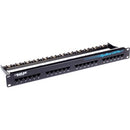Description
The Black Box GigaBase CAT5e Patch Panel delivers reliable, enterprise-grade performance in a compact 1U form factor. Designed for scalable network deployments, this unshielded CAT5e patch panel is engineered to provide consistent signal quality, easy administration, and durable operation in data centers, server rooms, and network closets. Component-level testing helps ensure stability across the entire channel, giving IT teams peace of mind that each connection will perform to spec under real-world loads. Whether you are upgrading a small office LAN or building out a larger routed network, this 24-port patch panel is built to handle day-to-day traffic with headroom for growth, while keeping cabling neat, organized, and easy to manage.
- Rigorous component-level testing for better overall channel performance and stability. This patch panel is designed to pass CAT5e with clear headroom for future upgrades, helping to minimize latency, crosstalk, and interference that can degrade critical network traffic.
- 24-port CAT5e capacity in a single 1U enclosure. The compact footprint fits standard 19-inch racks, making it ideal for structured cabling systems in dense network closets. The unshielded (UTP) design supports cost-effective deployments without compromising reliability for typical office and data-center environments.
- Integrated cable management bars for streamlined organization. These bars guide and support cables as they enter and exit the patch panel, reducing bend radii, improving airflow, and simplifying future rearrangements or expansions while maintaining clean, professional cabling layouts.
- Universal wiring with labeling for fast, error-free cross-connecting. The patch panel supports T568A and T568B wiring schemes, and comes with clear labeling options to keep port assignments visible at a glance, simplifying maintenance and troubleshooting.
- Durable build and universal compatibility with standard hardware. Constructed to work seamlessly with typical 19-inch racks and standard RJ45 components, this patch panel provides dependable performance in a wide range of network environments and is ready for immediate deployment in new or existing infrastructures.
Technical Details of Black Box GigaBase CAT5e Patch Panel - 1U, Unshielded, 24-Port
- Port count: 24 RJ45 ports
- Standard: CAT5e, unshielded (UTP)
- Mounting: 1U height for standard 19-inch racks
- Wiring compatibility: Universal wiring with support for both T568A and T568B schemes
- Cable management: Integrated cable management bars for organized routing
- Labeling: Includes labeling to identify ports and connections for easy maintenance
- Construction: Robust panel designed for reliable performance in data centers and network closets
How to install Black Box GigaBase CAT5e Patch Panel - 1U, Unshielded, 24-Port
Preparing for installation begins with identifying the appropriate rack space. Ensure the rack is sturdy, level, and capable of supporting the weight of the patch panel once cables are connected. Gather the necessary mounting screws and cable ties, and have your labeling materials ready to assign port numbers as you go. Install the patch panel into the rack using the standard screws supplied with most 19-inch racks, aligning it with the centerline for balanced load distribution. Secure the unit firmly so it remains stationary during cable management and future maintenance.
Next, route your incoming and outgoing CAT5e cables through the rack, taking advantage of the integrated cable management bars. Leave enough slack to accommodate future moves or reconfigurations, but avoid excess slack that can complicate organization. Group related cables together using ties, but do not overtighten—proper strain relief is essential to maintain connector integrity over time.
Prepare the wiring for the patch panel by choosing a wiring scheme (T568A or T568B) and punching down each conductor onto the appropriate terminations. If your network already follows a specific standard, maintain consistency across all devices and panels to prevent crossover issues. As you terminate each port, apply the corresponding label to the panel faceplate or the adjacent labeling area to ensure quick identification during troubleshooting or future reconfigurations.
After all cables are terminated and labeled, perform a basic connectivity test with a cable tester to verify proper pinouts and continuity. Confirm that there are no shorts or miswires, and that each port corresponds correctly to the device or patch cord connected on the network side. Finally, tidy the cable runs, secure any loose cables with ties or clips, and re-check airflow and cable bend radii to maintain optimal environmental conditions for your networking gear.
Maintenance and future upgrades are straightforward with this CAT5e patch panel. When adding new devices or reconfiguring your network, simply extend the existing cable runs into newly labeled ports, keeping your patch panel organized and easy to navigate. Regularly inspect cable terminations for wear or loosening, and replace any damaged cables promptly to maintain performance and reduce the likelihood of intermittent connectivity issues.
Frequently asked questions
- What is the main advantage of using a 24-port CAT5e patch panel in a 1U form factor? A 24-port panel in 1U provides dense port density within a compact footprint, enabling scalable, organized cabling for small to mid-sized networks while maintaining a clean, professional rack presentation.
- Is this patch panel shielded or unshielded? This model is unshielded (UTP). It is designed for environments where shielding is not required or where shielded cables and connectors are used elsewhere in the network.
- Does it come with cable management bars and labeling? Yes. The patch panel includes integrated cable management bars and labeling to help keep cables organized and ports clearly identified.
- Can I use either T568A or T568B wiring schemes? Yes. The panel supports universal wiring and accommodates both T568A and T568B standards, allowing compatibility with existing cabling in your facility.
- What kind of maintenance is required after installation? Routine checks for cable strain, port labeling accuracy, and any signs of wear on cables or terminations are recommended. Periodic testing with a cable tester can help catch issues before they affect network performance.
Customer reviews
Showing - Of Reviews


